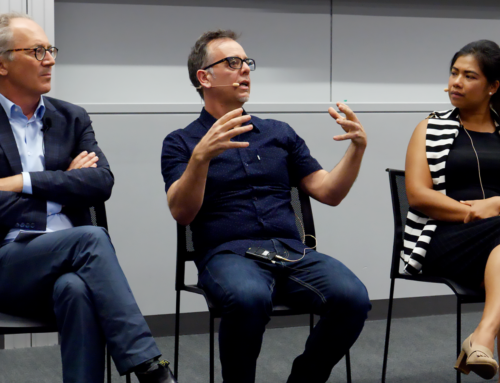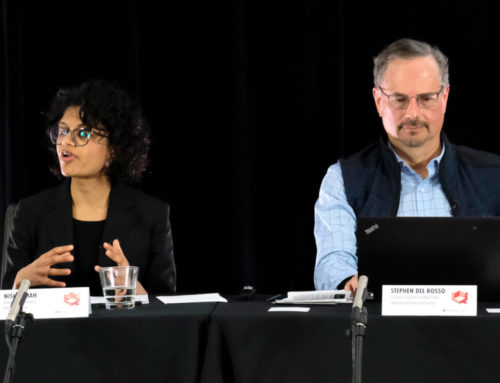Allison Bashford’s presentation for the biosecurity panel mentioned a mid-20th century idea of Warren Weaver to develop an independent, solar energy source providing every human being with a personal energy supply. Given humanity’s relative lack of follow through on the idea, coffee would have to suffice for participants still feeling jet lag and residual effects of the morning’s pre-panel activities.
The symposium reconvened after the break for Infosecurity: Cyberworlds, Surveillance, Cyberconflict and Global Media. The panel’s presenters all approached the topic with emphasis on the power inherent in information. Whether making meaning of images, collected and surveyed in of the biometric manifestations of 21st century biopower, structuring and situating potentiality through virtuality or exercising power through demonstrating competence in diplomacy, information is an integral component of power and security.
After an introduction to the panel by moderator Simon Tormey, no stranger to the manifold manifestations of power in his own work, Roland Bleiker began the presentations with his own work on images in international relations. While there were some clear similarities to the nascent research program outlined by Lene Hansen in her Hintze lecture two days earlier, Bleiker presented elements of a broad line of research he has been pursuing for some time.
The impact of images, he explained, is impossible to capture by looking for conventional causality. Images, as representations, do not cause events. They do construct an effect Bleiker called the “seduction of the real”- giving the viewer a sense of being witness to reality rather than viewer of constructed and framed representation. In spite of- or perhaps because of- this, images’ impact on policy is of considerable import- Bleiker is currently conducting research, along with Emma Hutchison and David Campbell, on the role of images in shaping response to humanitarian crises. Speaking to the local context, he spoke of research on the sort of images often selected to accompany articles on immigration to Australia. He highlighted the way these images construct and reinforce certain tropes, reinforcing categories such as “boat” people as somehow distinct and in opposition to those immigrating by air. Photographic content analysis showed that most photographs were group shots, which Bleiker hypothesized reduced the ability of the “viewer” to empathize with the subjectivity of those pictured.
Bleiker closed with his thoughts on the methodological dilemma of studying images, specifically alluding to the quantum problem of observation of wave-particle duality. For him, studying images and their impacts requires a mixed-methods approach emphasizing ethnography and semiology of the images of themselves, discourse analyses of the authority constructed through images, and more quantitative methods, like content and survey analyses, to understand the dispersal and saturation of images and their effects.

Charlotte Epstein (CISS) presents her research as Rebecca Adler-Nissen and Roland Bleiker look on. (Photo credit: Jose Torrealba)
Taking the panel towards a different kind of observation, Charlotte Epstein spoke of the increasing entanglement of biometrics and biopolitics in state surveillance. Building on her earlier research, she spoke of the highly fruitful interdisciplinary field developing on account of the salience and increasing omnipresence of the issue in contemporary life, evident in some work by other Symposium attendees such as Katina Michael’s Überveillance project. Epstein’s own work emphasizes Foucaldian notions of governmentality, discipline, and biopolitics, with biometric surveillance techniques mapping practices of subjectivity and power on to the body-political subject. To this, she also integrates insights from Lacanian psychoanalysis on the importance of privacy in the composition of the psychic subject.
Epstein related an anecdote of being invited to a cabinet-level meeting of Australian government officials, never to be invited back after probing the ethical and normative dimensions of policies rather than the technological possibilities that make a Big Data approach to biometric surveillance so alluring to the policymakers present. Her presentation served to emphasize the need for a multidisciplinary effort sufficient for understanding and theorizing the political and normative implications of the exponentially expanding reach of biometric surveillance and large-scale data collection. Though Epstein registered considered skepticism about a proposed “quantum turn” during the question period at the opening Q Panel, Epstein’s focus on the role of biometrics in changing constitutions of the political subject shares some similarities with the “quantum” notion that observation necessarily changes the properties of that being observed.
Picking up on subjectivity, the panel moved to Carolin Kaltofen’s presentation on the conceptual problem of notions of reality. She began by problematizing our notion of “reality” as something conflated with the material and the analog, highlighting our bias against the digital and leaving out the virtual, the realm of potentiality, altogether. Kaltofen argued that prioritizing certain sensory experiences over imperceptible forces is rather arbitrary in determining “reality”- does one smell electricity? Or touch code? The difficulty of acknowledging that digital realm is just as real as the analog, and that both are part of the actual, was traced back longstanding metaphysical struggles with invisible forces, notions of immanence, and questions of representation.

Carolin Kaltofen problematizes our conceptions of reality, flanked by Rebecca Adler-Nissen and moderator Simon Tormey. (Photo: Jose Torrealba)
But Kaltofen was careful to make clear that the digital is not the same as the virtual. Based on a Deleuzian ontology of the real, she identified the virtual as potential, immanence and future to come. This is not merely a matter of esotericism, but an effort to undo common misconceptions that equate reality with the actual, material realm and where the virtual as well as the digital are imagined to be distinct from reality. Kaltofen’s mapping of reality in the digital age aims further to demystify the workings and power of new technology for a more nuanced understanding of emergent disruptive technologies.
Practices of power featured prominently in the next presentation to the panel, as Rebecca Adler-Nissen presented some of her recent research on diplomatic practice. Some of the work, which focused on the NATO intervention in Libya and its predicate authorization from the UN Security Council, has been recently published in the European Journal of International Relations, in a paper co-authored with Vincent Pouliot. Adler-Nissen opened with the paper’s fundamental question: how does power work in practice?
In IR literature, power is often described as if a quotient or capability, able to be wielded or levied to exert social force. In practice, Adler-Nissen sees power functioning relationally, echoing David Baldwin’s claims that power is “situationally specific”. She argued for a concept of “emergent” power, in which the distinction between relation and capability-emphasizing notions of power is bridged. Emergence refers to the complex patterns that render a system more than the sum of its individual parts, with examples given of a traffic jam, ant colony, or a flock of birds in flight. Emergent power comes from the interaction of actors drawing on endogenous resources to influence social outcomes. By demonstrating competence in the practices of a shared field— high-level diplomacy, in the case of UNSC deliberations over Libya—actors wielded power over the course of action.
The research was based on 55 semi-structured interviews with diplomats and officials privy to the process. In patterns of power practice the UK was the “pen holder”, taking the lead on drafting Resolutions 1970 and 1973, while other members “fine-tuned” the draft. Meanwhile, US diplomats skillfully deployed the discourse of Srebenica while Germany and South Africa ended up mired and sidelined in deliberations, unable to wield much power in actual practice. While some of these effects are surely attributable to the resources of power as capabilities, Adler-Nissen argued that the case when examined in detail showed that Western leadership is augmented by relational power in addition to its rule-based structural advantages. This power depended on the recognition of competence, which in turn tied to considerations of knowledge and management of information.
All the presentations emphasized different facets of information and power: the power inherent in biometric Big Data, creating and propagating images, practicing competencies and the potential of virtuality. But in each there was a complementarity: it seemed one could not speak of information without power, with each insufficient for capturing the full range of the phenomena observed.






[…] But just as last year’s lecture by Lene Hansen on images in security spoke to themes that would recur throughout the conference, McKenzie Wark’s lecture “Exit to the Planetarium” was the perfect […]
[…] a Sydney summer sundown. Panels had touched on so many facets of security studies, natural and social science, ethics, epistemology, and security aesthetics that a single closing panel would have to […]
[…] skilled technicians. In her closing, Mackenzie left her mark a symposium already showing a repeated emphasis on imagery, with slides showing convicted PFC Chelsea (née: Bradley) Manning before and after her […]